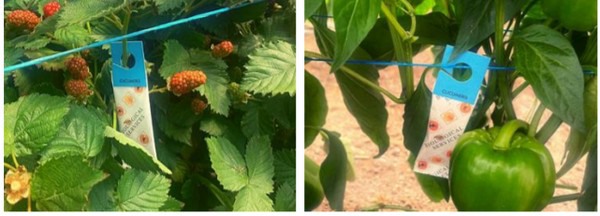Biological Services is trialling sachet technology for the slow release of predatory mites to improve commercial Integrated Pest Management (IPM) practices – and the trial results are very promising. Drawing on its experience as pioneers of IPM in Australia, the team chose to trial the sachet packaging first with the predatory mite, Cucumeris.
This benefit is effective in controlling trips in crops such as cucumbers, capsicums, eggplants, strawberries, other berry fruits, and ornamental crops. James Altmann, Director of Biological Services said the new sachets simplify releases for growers, ensuring a more even placement, and provide a continuous emergence of predators for about four weeks because they still breed inside the sachets once placed into the crop.
“Until now in Australia, the standard approach for releasing most predatory mites into crops has been with loose material shaken over the plants,” said James. “The current approach works and will continue to be used for many situations but applying loose materials is often difficult to calibrate, and we know that the more even the distribution over the crop, the better the results.”

“We can already see how much effort the new sachets will save growers. It is quick and easy to space sachets evenly throughout crops which saves labour. The formulation inside the sachet also provides a continuous release of predators for several weeks, reducing the need for multiple applications of loose material. A hook is supplied attached to each sachet and growers simply hang them every few meters on a leaf stem, string, or wire. The mites walk out onto the crop from a small hole at the top of each package.”
“50 years since we began, our team today is just as passionate about reducing the use of chemicals in agriculture by improving IPM practices and approaches. The sachets are emerging as a new option to simplify IPM for commercial growers across the country.”
Trials
These trials and the commercialization of sachet technology have been made possible with the support of our international partner Biobest. This project is an example of the benefits Biological Services can deliver to our customers through greater access to global technology and the ability to fast-track ideas that would have taken much longer on our own. Sachets have been used successfully overseas for many years, but the cost of the machinery didn’t match the market potential in Australia.
Biobest has helped a lot in making this a reality here. With thorough first phase testing complete, the Biological Services team is now collaborating with key commercial growers with monitored field trials. This is the final stage in the process of bringing the benefits of this technology to all growers early next year and expanding the range of predators available in sachets. Whilst Cucumeris is the first product, we will release both Californicus for Spidermites, Montdorensis for Whitefly/Thrips early in the new year, and then continue trials with Doreenae in almonds/grapes for various mite pests at the same time.
For more information:
Biological Services
08 8584 6977
[email protected]
www.biologicalservices.com.au
